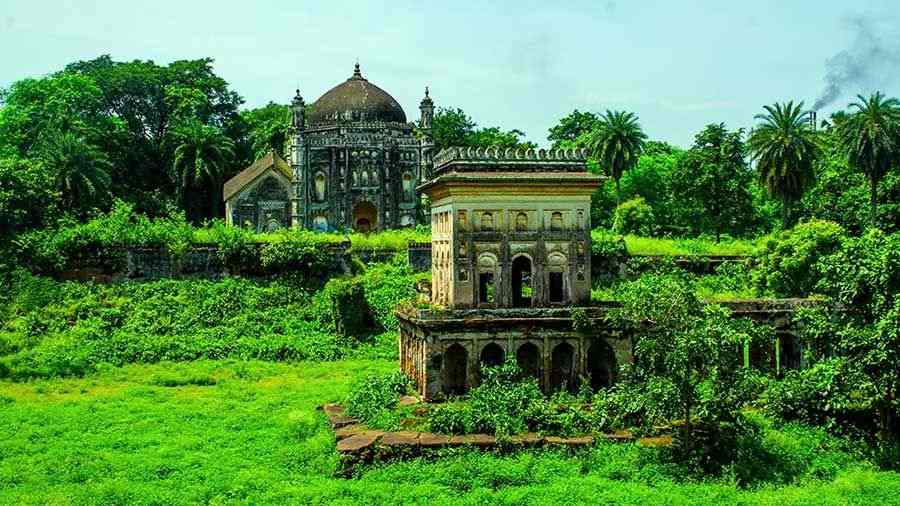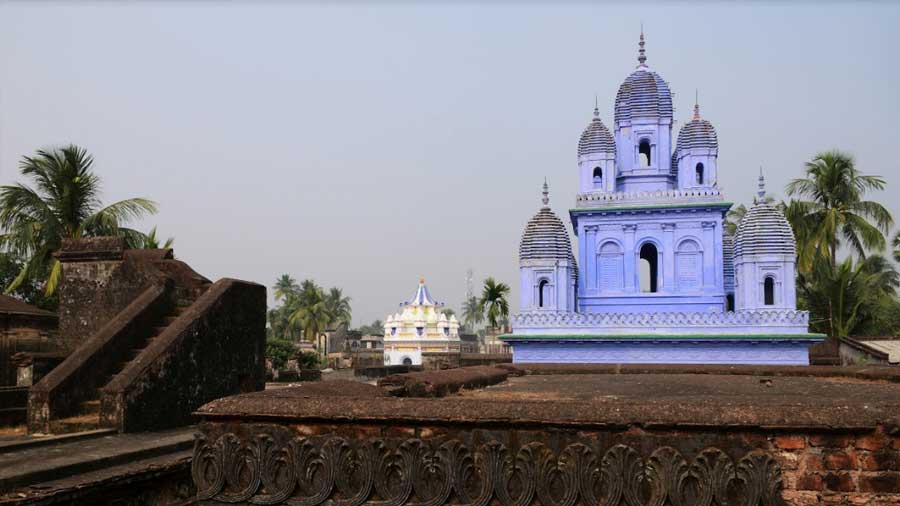When one thinks of a temple town in Bengal, it is Bankura’s Bishnupur that first comes to mind. Not many know that, just in one of the neighbouring districts, there is another town that can be a contender for the same title. In fact, if it ever comes down to a wider array of architectural styles, this town might just be unbeatable.
Ambika Kalna, located in the East Burdwan (Purba Bardhaman) district, is a heaven for those who wish to explore Bengal’s brilliant temple architecture. From deul style to aatchala, Pancha Ratna to 25-pinnacled structures, Ambika Kalna has it all. The town must be at least a thousand years old, as is corroborated by the recovery of Bishnu temples dating back to the 10th and 11th centuries from the Bhagirathi river that flows close by.
Ambika Kalna has been historically significant too. In 1298, Jafar Khan Gazi conquered Saptagram in the nearby district of Hooghly. Many historians opine that Ambowa was a vital military base for Muslim rulers during that period. During the Hussein Shahi dynasty, several mosques were built at Ambika Kalna between 1490 and 1559. The early 16th century saw the arrival of Shri Chaitanya Dev, which was followed by a rapid expansion of Vaishnavism in the region.
Interestingly, Ambika Kalna wasn’t always the name of the town. Referred to as ‘Ambowa Muluk’ in Mangal Kavyas, Ambika Kalna is labelled ‘Ambowa’ in a 1660 map of Bengal. In the 19th century, the name of the place changed from Ambowa to Ambikanagar. It is popularly believed that this new name was derived from the word ‘Ambika’ — one of the many names of Goddess Durga, the deity worshipped by the people of the town.
There are temples galore in Ambika Kalna. The majority of the terracotta temples that visitors get to see today were built by the kings of Burdwan during the 18th and 19th centuries. As one tours the town, it becomes apparent that there is an exciting variety of architectural styles and a unique story behind each edifice.
The Rajbari complex temples
The Rajbari complex in Ambika Kalna houses several temples and is considered to be the town’s chief tourist attraction. Some of the magnificent edifices enclosed within the palace premises that tourists usually look forward to include the Pratapeshwar temple, Rasmancha, Laljiu temple, Giri Gobardhan temple, Krishnachandra Temple, Vijay Vaidyanath temple and Rupeswar Shiva’s Chandni.
Pratapeshwar temple
This deul-styled temple was built in 1849 under the supervision of Pearykumari Devi, the first wife of Raja Pratapchand (son of King Tejchandra). The highlight is the temple’s wall, at the centre of which are elaborate depictions of the battle between Ram and Ravana. There is also an intricate engraving of Goddess Durga triumphing over Mahishashur.
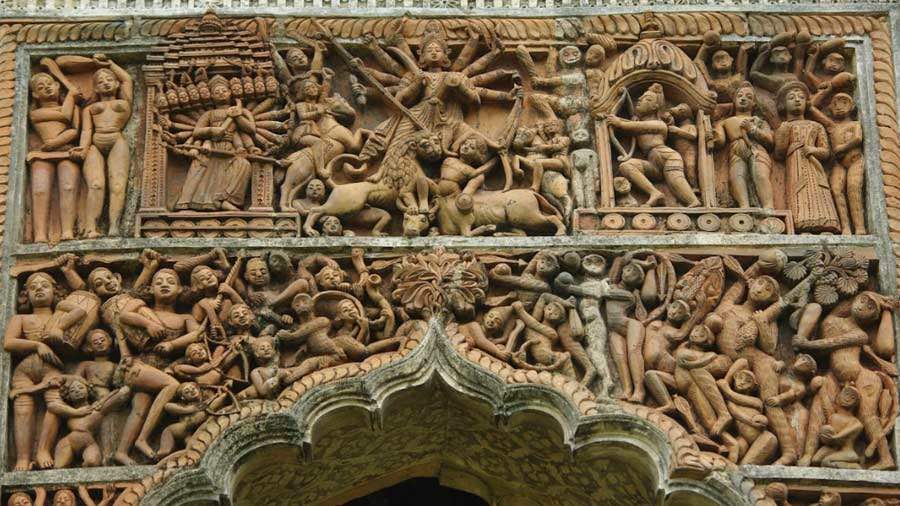
Engraved on the temple walls is a figure of Goddess Durga as Mahishasurmardini and a scene from the Ram-Ravana battle
Rasmancha
The Rasmancha is a roofless structure with a dome-shaped pinnacle and has two sections. The outer section has 24 gateways and the inner has eight.
Laljiu temple
A 25-pinnacled structure, the Laljiu temple was built in 1739 by Raja Kirtichand Rai of Burdwan for his mother Brajakishori Devi. Located inside a separate enclosure, this temple has a charchala (four-eaved roof) natmandir.

Of the three twenty-five-pinnacled temples in Ambika Kalna, the Laljiu temple is the oldest
The terracotta motifs on its walls depict scenes of Krishnalila, Europeans hunting on horsebacks and British soldiers with guns. The presiding deity of the temple is Radha and Krishna.
Giri Gobardhan temple
Built in 1758, the Giri Gobardhan temple is located within the same enclosure as Laljiu. The roof, designed to resemble a mountain, is studded with figures of humans and animals. The architectural style that this temple follows came to existence quite later in Bengal’s temple architecture history.
Krishnachandra temple
Another 25-pinnacled temple, the Krishnachandra temple was built in 1751 by Raja Trilokchand to honour his mother Lakshmikumari Devi. The temple is built in a style similar to that of the Laljiu temple, although this structure stands in another enclosure. The temple walls are decorated with gorgeous terracotta work. The presiding deities of this temple are Krishnachandra and Radha.
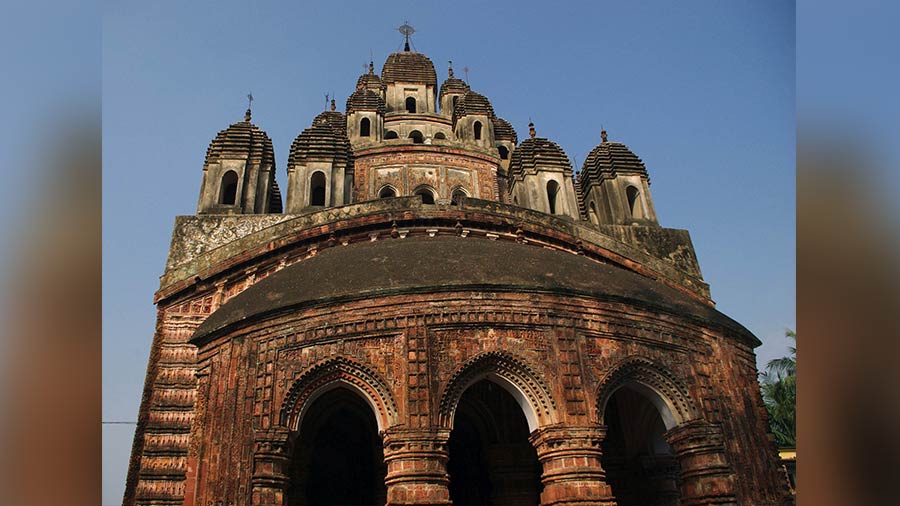
The Krishnachandra temple has intricate terracotta work on its walls
Vijay Vaidyanath temple
This temple was built by King Trilokchand to honour the wish of his mother, who had prayed to Shiva for a son. The Vijay Vaidyanath temple is in the same enclosure as the Krishnachandra temple.
Rupeswar Shiva’s Chandni
A flat-roofed temple, Rupeswar Shiva’s Chandni was built in 1764 by King Tilakchandra’s first wife Rupkumari Devi. Close to it are five small aatchala (eight-eaved roof) temples.
The temples inside the Rajbari complex are maintained under the supervision of the Archeological Survey of India (ASI). Just outside the palace complex, there are two other five-pinnacled temples that visitors can check out.
Ramesvar temple
Located just behind the Rajbari complex, the Ramesvar Temple is an aatchala brick temple dating back to the 18th-19th century. The frontal facade of the temple is embellished with beautiful lotus rosettes and medallions. The site is maintained by the Archaeological Survey of India (ASI).
Nava Kailash temples
Locally known as the 108 Shiva temple complex, the Nava Kailash temples were built in 1809 by Maharaja Tejchandra, the king of Burdwan. The temples are so arranged that they form two concentric circles.

The temples of Nava Kailash, arranged in perfectly concentric circles
The inner circle has 34 temples with white Shiva lingams. The outer circle has 74 Shiva temples with alternating black and white Shiva lingams. Like the Ramesvar temple, this temple complex too is looked after by the Archaeological Survey of India (ASI).
Siddheswari Kali Temple

The Siddeshwari Kali temple is a Jor Bangla temple whose original structure was laid down by Ambu Rishi in the 7th century
It is believed that the Siddheswari Kali Temple, built in the architectural style of Jor Bangla, was originally established by Ambu Rishi in the seventh century. The edifice that visitors see today is a renovated structure, an endeavour taken by King Chitrasen Rai (son of Kirtichand Rai) in 1741. The presiding deity of the temple is goddess Kali and the idol is made of neem wood.
Anantabasudev temple

The Anantabasudev temple and the Basudev idol within
Like the Ramesvar temple, the Anantabasudev temple is another aatchala temple and was built in 1754 by Raja Trilokchand (cousin of Raja Chitrasen) to honour Chitrasen’s grandmother Brajakishori Devi. The temple houses a four-foot-tall idol of Basudev made of kastipathar, which is an exquisite work of art.
Goplajiu’s temple at Gopalbari
Another one of Ambika Kalna’s 25-pinnacled brick temples, Goplajiu’s temple was built in 1766 during Trilokchand’s rule. The walls of the temple are uniquely adorned with erotic terracotta motifs depicting European men and local women.
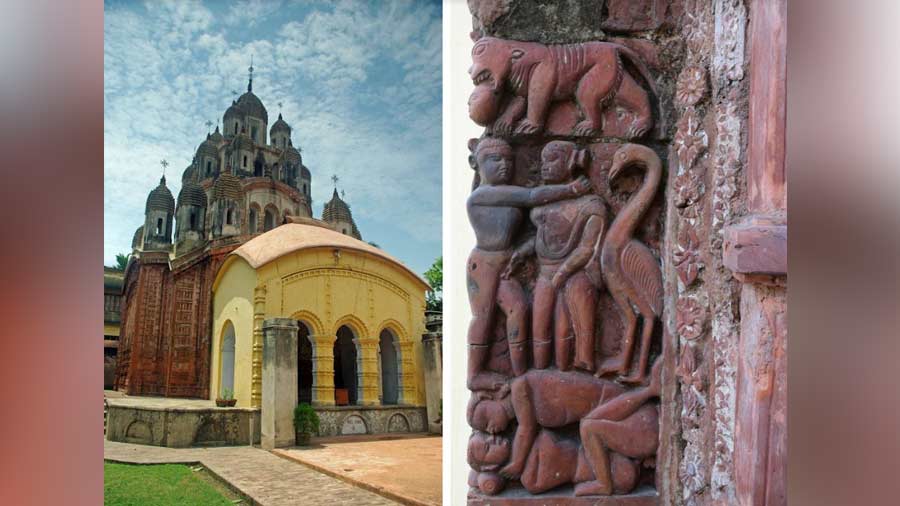
Erotic motifs adorn the walls of the twenty-five-pinnacled Goplajiu’s temple
Temples of Jagannath Bari
The three temples of Jagannath Bari were built in 1753 by two queens of King Chitrasen — Chandakumari Devi and Indukumari Devi. Today, standing on the banks of Bhagirathi, the temples are a sad sight to behold. Despite the visible signs of dilapidation, on two of the temples, visitors can still catch a glimpse of the intricate terracotta work that once graced the walls.
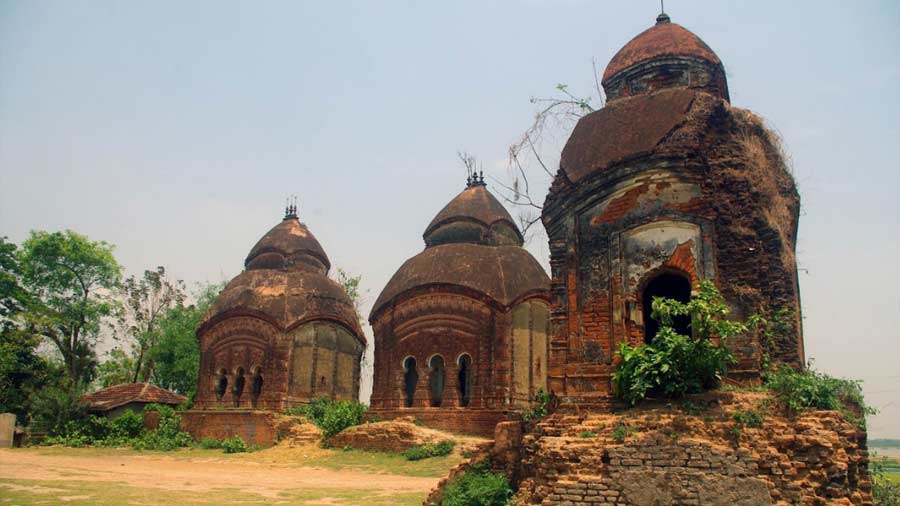
The three temples of Jagannath Bari are in a state of ruin
Mahaprabhu Bari
Built by Gauridas Pandit, Mahaprabhu Bari is Ambika Kalna’s first-ever temple dedicated to Shree Chaitanya. Along with Nityananda Prabhu, Shree Chaitanya had visited Ambika Kalna twice to meet Gauridas Pandit. The temple houses a handwritten Gita which was a gift from Shree Chaitanya.
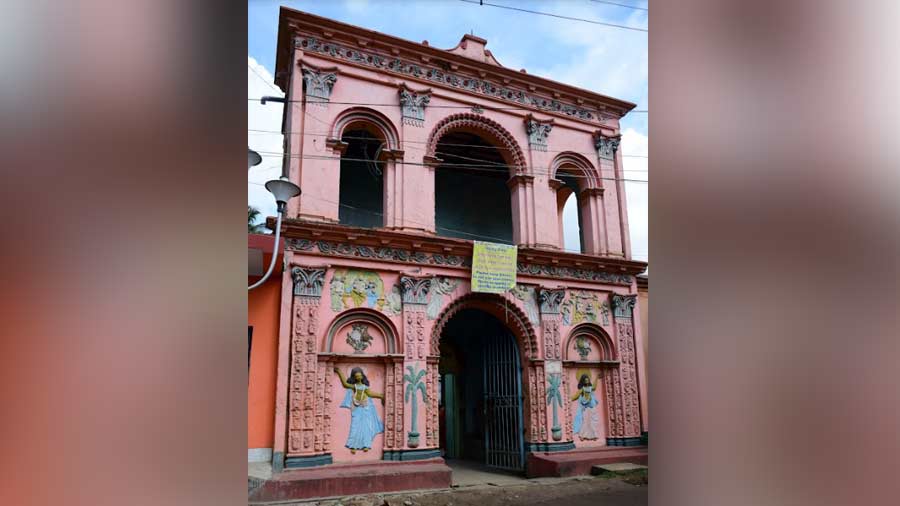
The entrance to Mahaprabhu Bari
Besides these temples, one can also visit the Datan Kathi Tala Masjid, which is the oldest surviving mosque in Ambika Kalna.
Travel details:
- There aren’t any express trains to Ambika Kalna, and the easiest way to reach the destination would be via local trains. If you are in the mood for a road drive from Kolkata, take the Durgapur expressway to reach Ambika Kalna (Gurap and Bainchi are two villages you will be passing by).
- Once you are all settled in and ready to tour the town, a hired toto can take you around. You just need to inform the driver about all the spots you wish to visit.
- No site in Ambika Kalna charges any entry fees except the Rajbari complex, where visitors have to pay Rs 25 if they wish to shoot a video within its premises.
- The accommodation facilities in Ambika Kalna are fairly spartan, as are the eateries. One relatively better option among the ones available is Hotel Priyadarshini.

